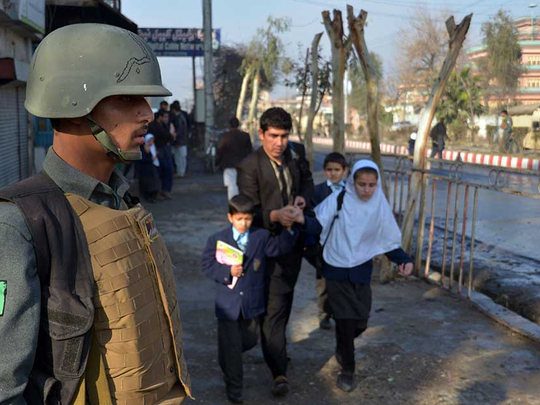
Delegates from Pakistan, Afghanistan, China and the United States met in Islamabad on January 11 to revive efforts to start peace talks to end the conflict in Afghanistan.
At the end of the day the delegates “emphasised the immediate need for direct talks” between the Afghan government and the “Taliban groups”. Pakistan called for an unconditional offer of talks to the Taliban. The next meeting of this four-nation group is scheduled in Kabul on January 18.
Direct talks with the Taliban stalled after one meeting in Murree (Pakistan) in July last year after it became known that the Taliban chief Mulla Omar had died two years ago. Both China and US were part of that meeting. Since China is the only one outside the conflict, it could play a critical role as facilitator.
Conditions within Afghanistan are worrying. Following Taliban battlefield successes in 2015, top Afghan officials privately voice an increasingly grim assessment of situation on the ground. With 700 killed and 12,000 injured, the Afghan National Defence and Security Force (ANDSF) casualties have risen 26 per cent in 2015 over the previous year.
Attrition rates are soaring. Pakistan’s military operation in North Waziristan has pushed thousands across the porous border, swelling the militant ranks there. They now control nearly 30 per cent of Afghan territory — the highest since they were ousted in 2001. The militants are at the doorsteps of several major towns. Helmund, close to Pakistan border with 18,000 ANDSF stationed there is particularly vulnerable. The Pentagon is reportedly pushing to keep the Bagram Air Base — a key US operational centre — open beyond 2017.
Unsettled conditions prevent the return of Afghan refugees, of which three million are still believed to be in Pakistan. The International Office of Migration estimates that Afghans constitute the second-largest group (11 per cent) of over a million refugees that have crossed into Europe last year.
The US brokered National Unity government remains deeply divided and has little to show for security, economy and governance that are all key to returning Afghanistan to stability.
As the institutions remain weak the militants are able to tap onto to marginalised and disaffected communities in Afghanistan, sustaining the resistance.
Pakistan may have influence but it does not control the fractious Taliban. Others think differently. Given Pakistan’s own fragile polity using force to compel them to talk will be counter-productive.
The non-Pashtuns, still holding key political power levers, represented by the chief executive Dr Abdullah Abdullah don’t like Pakistan. The Pashtuns in the ruling establishment resent Pakistan’s big brother attitude. Consequently, declarations of goodwill towards Pakistan from every new government in Kabul turn sour within months. The Gani regime is the latest in the series. Pakistan believes, non-deliverable expectations cause this let down.
Afghanistan has the tradition of a country divided within but united against invaders. In the current phase, since 9/11, after the regime change in Kabul, the US shifted the objective to bringing in western style democratic and social values to a tradition-ridden society like Afghanistan.
The US belief that the Western concept of democracy is panacea to modern-day problems will only be answered in time. But spreading this idea through force and acting in complete contrast to these belief’s compels nationalists to react against the concept itself. Military power alone cannot overcome the fundamental ambition of Afghan nationalism or for that matter any other.
The British and Soviet Empires learnt it the hard way. The US is already into its longest war. No imperial power attempting to control Afghanistan understood Eduard Bernstein, the European democratic socialist of the 19th century, when he advised: “The goal, whatever it may be, is nothing ... the movement is everything.”
Distrust between the US and Pakistan on how the future of Afghanistan needs to be shaped remains at high levels. Suspicious of letting India in, Pakistan’s equation is simple — seek maximum influence and minimise India’s influence in Afghanistan. And given the India-Pakistan divide, India wants to maintain its foot in the Afghanistan door.
Afghan stability is deeply intertwined with that of Pakistan. The world community needs to understand that Pakistan, in addition to a 2,700km long border, shares so much more with Afghanistan and give space to Pakistan, so that it does not feel constrained on its western border. A troubled, nuclear powered state at odds with its neighbours is bad for the region.
One face-to-face meeting in 15 years of present conflict between the protagonists does not offer much hope. As the four-nation committee attempts to get the Taliban to the negotiating table, the protagonists will have to concede ground and find a compromise. The Taliban are not going to get unbridled power this time around. And similarly, it is unrealistic for the Kabul government to assume that the Taliban accept the constitution and just join in.
Staking the stability of Afghanistan only on the military force that triggers militancy is not a sustainable solution. The eventual withdrawal of foreign forces needs to be blended with a simultaneous evolution of Afghan cultural and political ethos coupled with economic and social reforms. Neglecting these vital issues will leave Afghanistan and the region in their current state of conflict.
The path to Afghan reconciliation remains thorny and complicated.
— Sajjad Ashraf is an adjunct professor at the Lee Kuan Yew School of Public Policy, National University of Singapore. He was a member of Pakistan Foreign Service 1973—2008 and served as Pakistan’s Consul General in Dubai during 1996-1998.








